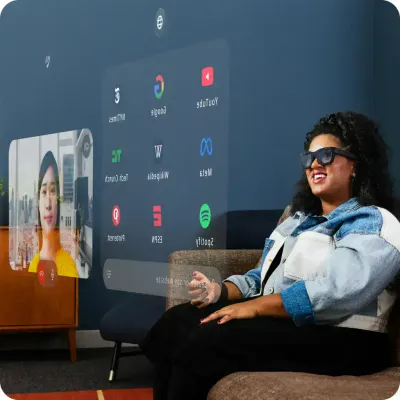The Evolution of E-Commerce: From Desktops to AR Glasses #
In the current state of e-commerce, we've seen a significant shift from desktop shopping to mobile-first experiences. People have found mobile devices more convenient for shopping, leading to a design trend where everything is optimized for smaller screens. As a result, user interfaces have become very vertical and compact, fitting within the limited space of a mobile screen.
However, this mobile-first approach is dying(okay not fully fully dying, but if AR is fully out, then yes, we will see a huge shift from mobile AR glasses experience).
With the rise of AR glasses, this trend is about to take another dramatic turn. AR glasses will effectively remove the limitations of screen size, allowing for a more expansive, immersive shopping experience. Big typography and bold visuals are making a comeback. The constraints of small screens will no longer dictate design choices. Are your products ready for this change?
This shift will require a complete overhaul of the current UI and UX design principles to accommodate the new, "unlimited" screen real estate provided by AR.
A New Way of Browsing: Multi-Dimensional Navigation in AR #
Currently, whether on desktop or mobile, we experience websites in a linear, one-page-at-a-time format. Navigation involves moving from one page to another, and the experience is confined to a single screen. But AR glasses are set to revolutionize this by offering a multi-dimensional browsing experience.
Imagine an e-commerce store where the homepage hovers to your left, the product page floats to your right, the FAQ is displayed on the floor, and the checkout is positioned above. This "surround screen" environment will allow users to interact with multiple pages simultaneously, drastically changing how we browse and shop online.
Navigation through the website will become more intuitive and immersive. Instead of clicking buttons, users might navigate with simple gestures or even eye movements. 3D models and visuals will play a key role, allowing customers to view products from all angles. This shift will lead to a complete revamp of the UI/UX design, making it more engaging and aligned with the capabilities of AR glasses.
Integrating Real Environments: Context Becomes King #
One of the most groundbreaking aspects of AR glasses is their ability to merge digital content with the real world around us. Context and physical environment are becoming part of your website. Before, your website did not know where it was being viewed. Now, all that is changing. If you are selling tea or a TV, it can be easily shown in the best way within the environment it is intended for.
Imagine sitting in your living room, watching TV, and simultaneously browsing for a new sound system. With AR, the e-commerce platform could display the speakers directly within your living room, giving you a true-to-life preview of how they would fit and look in your space.
This technology can extend to various scenarios. If you're in your bedroom and shopping for new bedding, the website could recognize your environment and tailor its suggestions accordingly. This level of personalization was never possible before, as websites were essentially blind to where we were browsing from—whether it was the living room, the car, or even a park bench.
Beyond the user experience, optimizing the add-to-cart and checkout process in an AR environment is key to converting interested users. AR glasses will change this by creating a seamless blend of online shopping and our immediate surroundings. E-commerce platforms will have to adapt, developing new ways to present products that consider not just the user's preferences, but their physical environment as well.
The Shift from Visuals to Audio: Redefining Content in AR #
In today's mobile-first world, shopping is primarily a visual experience. We scroll through images, read text, and often keep the audio muted due to our surroundings. Whether we're in a public place or simply not in the mood for sound, audio is usually secondary—unless we're using headphones.


AR glasses, however, are set to change this dynamic completely. With these glasses, audio can be experienced privately, creating an opportunity to integrate sound more seamlessly into the shopping experience. As a result, we may see a shift where audio becomes just as important—if not more so—than visuals.
The reliance on text could diminish as well, with audio cues and descriptions taking the lead. Imagine browsing through products and hearing detailed descriptions or promotional messages directly, without needing to read lengthy text. This will create a more immersive and engaging shopping experience, tailored to individual preferences and environments.
The Role of Search and SEO in the AR Era #
Search and SEO will evolve with the advent of AR. Users might search using voice commands or gestures. Websites need to optimize for these new methods. Content should be easy to find and interact with in an AR environment. Traditional SEO strategies will need to adapt to account for spatial browsing and new forms of user interaction.
Web Technologies and Integration Challenges #
Current web technologies must adapt to support AR features. Integration becomes crucial. Websites with rigid platforms and deep integrations may struggle to pivot quickly. Businesses using flexible setups can adapt faster. Being able to integrate AR functionalities smoothly will be a significant advantage.
Is Shopify Ready for the AR Revolution? #
One crucial question remains: Are current e-commerce platforms like Shopify ready to embrace AR, or will this shift bring about a change in industry leadership? Platforms like Shopify are heavily focused on AI and dumping unlimited text into product descriptions. However, this text-heavy approach may not translate well into an AR environment where visuals and context take precedence.
Shopify's readiness for AR is uncertain. They may not be prepared to provide the level of integration and flexibility required for AR functionalities. Businesses should assess if their platforms can support AR features. Being prepared can offer a competitive edge.
As Shopify is now leading the market, it is important to know how Shopify's platform is preparing for the AR revolution and how businesses can leverage Shopify CRO to optimize their stores for this new era of e-commerce.
Design UX/UI: The Limitations of AI in AR Design #
Designing UX and UI for AR is challenging. AI tools for design are not yet up to the task. Have you ever tried to generate meaningful UX/UI design using even the latest models of AI? They often produce abstract or unclear results. It masks the inability to make something clear and exact under the guise of creativity and abstract design.
AI tools can't replace human creativity and precision in creating effective AR interfaces.
Human creativity and precision are needed to create effective AR interfaces. The unique demands of AR require designers to think differently, focusing on clarity and user experience in a three-dimensional space. Businesses should invest in skilled designers who can navigate these challenges.
A Golden Opportunity for Smaller Brands #
The advent of AR in e-commerce is more than just a technological shift; it presents a unique opportunity for smaller brands to outmaneuver their larger competitors. For big brands like Amazon, transitioning to AR could be a massive undertaking, requiring significant time and resources to adapt their vast databases and systems to this new reality. This could slow down their ability to fully leverage AR, leaving room for more agile, smaller brands to take the lead.
Beyond brand size, the technical architecture of a website plays a crucial role in its ability to adapt to AR. Websites that have integrated deeply into complex automation systems and rigid platforms may find it difficult to pivot quickly to new technologies. For example, if an e-commerce store is heavily reliant on a platform like Shopify—using its checkout system, ecosystem, and entire infrastructure—it will be dependent on how quickly Shopify can transition to AR capabilities. This dependency can act as a bottleneck, slowing down the brand's ability to innovate and adapt.
On the other hand, websites that have maintained a simpler, more independent setup—free from deep integration into a single ecosystem—will find it easier to make the leap into the AR space. Their flexibility allows them to experiment, innovate, and implement AR features more rapidly than their larger, more complex competitors. This independence could be the key to seizing the moment and establishing themselves as leaders in the next era of e-commerce.
Are Current E-Commerce Platforms Ready for the AR Revolution? #
As we stand on the brink of this new era, one crucial question remains: Are current e-commerce platforms ready to embrace AR, or will this shift bring about a change in industry leadership? Today, the success of an online store often hinges on how well it's optimized for mobile devices. Platforms that excel in mobile optimization tend to outperform those that lag behind, even if the latter have potential.
However, the transition to AR could level the playing field or even shift the balance of power. E-commerce platforms that are slow to adapt to the AR environment might find themselves outpaced by competitors who embrace these new possibilities. The leaders in this space will be those who not only understand the technical aspects of AR integration but also how to create seamless, immersive experiences that truly resonate with users. For more insights on the future of e-commerce and key CRO statistics for 2024, check out our latest report.
The shift to AR isn't just about making existing websites compatible with new technology—it's about rethinking the entire shopping experience from the ground up. Those who can innovate and lead in this space will define the future of e-commerce.
Shopify for $1/month + Earn 1% of all sales as subscription credits, up to $10,000.
Glossary Terms in This Article:
- Cart: A cart holds items for purchase in Shopify before checkout.
- Checkout: Checkout is the process of completing a purchase in Shopify.
- CRO: CRO increases user conversions to maximize traffic ROI.
- Ecommerce: Ecommerce is buying or selling products/services online.
- Personalization: Personalization customizes shopping based on preferences.
- SEO: SEO means Search Engine Optimization for store visibility.
- UX/UI Design: UX/UI Design enhances user interaction and interface appeal.
Frequently Asked Questions
Quick Answers for AR Glasses Ecommerce
- What are AR glasses and how do they work?
- AR glasses are wearable devices that overlay digital information onto the real world. They use cameras and sensors to track your environment and display virtual content.
- How will AR glasses change online shopping?
- AR glasses will allow shoppers to virtually try products, see how items look in their space, and get real-time product information without leaving their home.
- When will AR glasses be widely available for shopping?
- Major tech companies are expected to release consumer AR glasses in 2025, with shopping features being a key focus of the technology.
- What are the benefits of shopping with AR glasses?
- Benefits include reduced returns, better product visualization, and a more immersive shopping experience that combines the best of online and in-store shopping.
- How can businesses prepare for AR shopping?
- Businesses should start optimizing their product images and 3D models for AR viewing, and consider how their current ecommerce platform can integrate with AR technology.